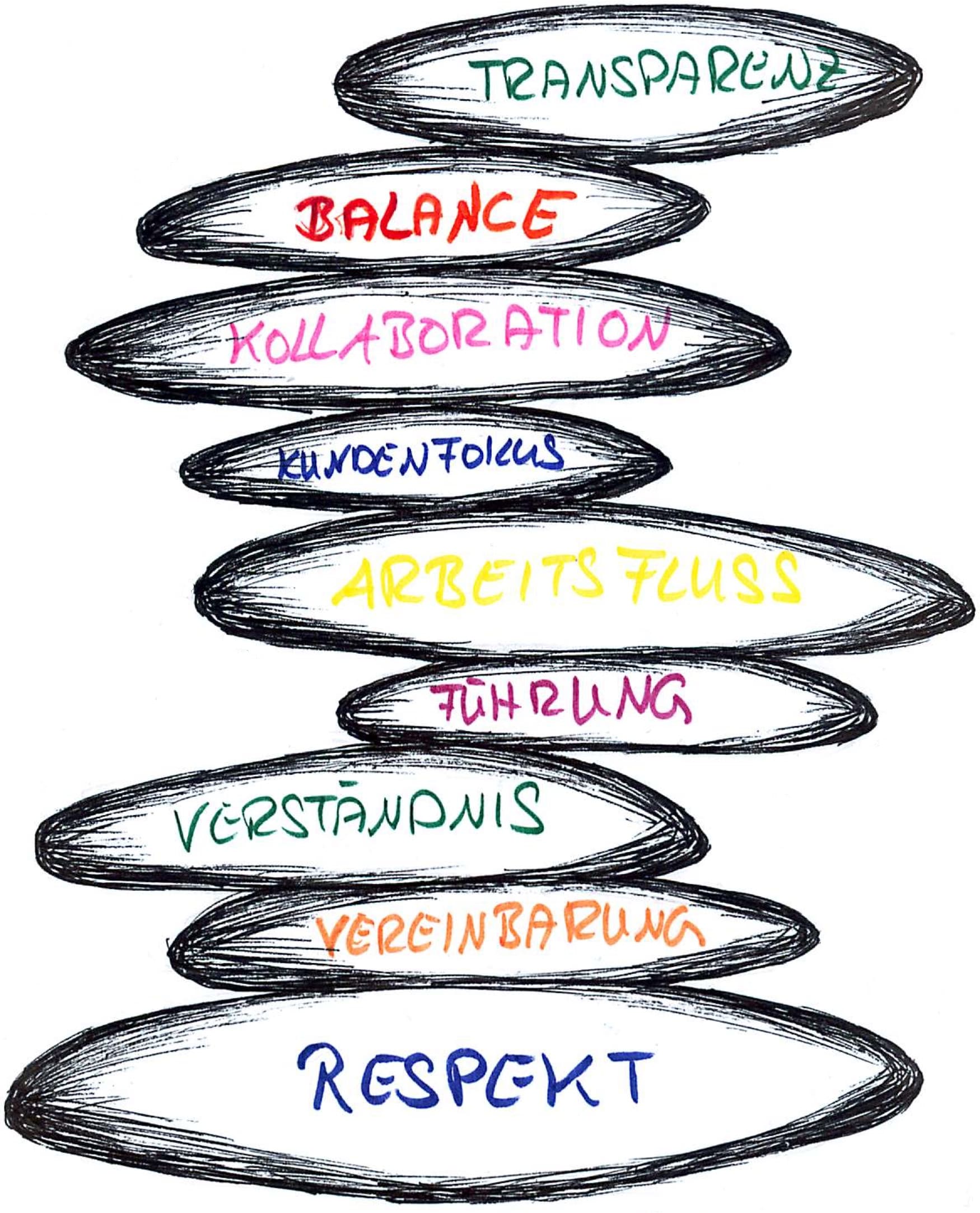Kanban in Organizations Part I
The Values and Foundational Principles of Kanban

This article describes the basic idea of Kanban based on its values and foundational principles. The Kanban method is regarded as the human start with what you are doing now approach to change. It should be seen more as a management method constructed around a value system than as a pure productivity tool. This method helps organizations to work better for their employees, customers and stakeholders. The basis of this article is the book "Essential Kanban Condensed" by David J. Anderson and Andy Carmichael.
What is Kanban?
Kanban is a method visualizing your work. It gives you a common understanding of the work you are doing. This includes the rules by which you do the work, how much you accomplish in a given time, and how good your work results are at the end.
As soon as you have gained this collaborative understanding, you begin with change. Your work is more predictable and your pace of work becomes more sustainable. Communication and cooperation improve and quality increases. Employees are able to act more independently as they develop a natural understanding of risk management.
Kanban also helps you to better align your entire organization and to realize far-reaching strategic goals. In addition, it focuses on the structured design of commitments between the people involved in the work process and on a balanced workflow. This leads to more agility in the organization. If the conditions in markets change, the use of Kanban makes it possible to change course quickly.
The Kanban values
The Kanban method is motivated by the attitude that all persons contributing to a common company must be respected. This mutual respect is essential if the company is to succeed and pay off. Without this mutual respect, the company itself is not promising. The Kanban method is based on a system of nine values. Respect is the foundation on which the other values are built. They essentially summarize why the principles and practices of this method exist at all:
Transparency
By an open exchange of information and a clear and unambiguous vocabulary you create transparency in all areas.
Balance
You are efficient if you balance the different requirements, views and abilities of all participants among each other.
Collaboration
The Kanban method improves the way people work together. Collaboration is therefore one of its key points.
Customer Focus
The customers and the value (asset) they receive are the natural centre of interest of all persons involved in the company.
Workflow
Work represents a continuous or occasional flow of values. An important starting point in using Kanban is to recognize and maintain such a flow of work.
Leadership
Leadership is required at all levels to create value and achieve an improved state.
Understanding
Understanding means first and foremost self-awareness, both from the individual employee as well as from the entire organization to move forward. Kanban is a method of improvement and improvement requires change, which in turn requires understanding. Once you have identified a particular problem, you determine cause and effect. This means you need to understand your work and the processes involved first in order to improve it: Start with what you are doing and understand why you are doing it.
Agreement
In an agreement, all parties agree to pursue goals together. Different opinions and approaches must be respected. These different points of view should converge. This rapprochement arises from the joint commitment of the persons involved to improve all processes necessary for the joint achievement of the objectives.
Respect
Respect for people in the form of appreciation, understanding and consideration is the foundation on which the other values are based: Start with what you are doing and look at how what you are doing meets or does not meet the needs of people inside and outside the organisation.
These values are the motivation of Kanban to continuously improve teamwork and the services produced. You apply the Kanban method analogously if you accept these nine values.
The Kanban agendas
Kanban considers three agendas for change necessary to organization success:
The Sustainability Agenda
The Service Orientation Agenda
The Survivability Agenda
The Sustainability Agenda is about finding a sustainable pace of work and optimizing the focus on the inside of the organization. Its goal is to create services that balance demand with existing performance. When demand exceeds performance, employees are overloaded with work. Introduce transparency about the workload and bring it into balance with the performance of the employees. You create thus a basis empowering all employees to complete their work in a regular rhythm and not to overwork themselves.
The Service Orientation Agenda deals with the performance of the company and customer satisfaction. It focuses on the customers and starts from the actual purpose of the company. Kanban is about providing services and continuously improving them. The goal of the Service Orientation Agenda is to provide customers with the services which meet the company's purpose. On the other hand, they should meet or exceed the needs and expectations of the customers. When all people involved in the company focus on this, it achieves excellent results.
The Survivability Agenda is about staying competitive and adaptable. It deals with the future of the company. Its aim is to ensure that it continues and is successful in times of significant change. Technologies and processes that are currently sufficient must be adapted to constant change. With its evolutionary approach to change, Kanban is well suited to meet these challenges.
The foundational principles of Kanban
Kanban has six foundational principles, which are divided into two groups:
The Change Management Principles
The Service Delivery Principles
Kanban brings change in all areas of the organization. People are rather sceptical about change. It makes the future more uncertain and they equate it with dangers and risks. An organization consists of a network of individuals who are psychologically and socially linked to each other and fundamentally resist to too many changes. Kanban recognizes these aspects of human behavior through the three Change Management Principles:
-
Start with what you do now.
-
Agree to pursue improvement through evolutionary change.
-
Encourage acts of leadership at every level.
Start with what you do now: It is important that you understand current processes and how they are implemented in practice. Existing roles, responsibilities and job titles must be respected. If you value current practices and professionals, you may expect a reduced resistance to change. It is therefore crucial to include every person involved in the company in order to successfully master future challenges. While the current processes have their obvious shortcomings, they also show levels of resilience and sophistication. Otherwise they wouldn't have achieved to get established over time. Even those who work with these processes are usually unable to fully assess the complete extent of their advantages or disadvantages.
Agree to pursue evolutionary change and promote leadership at all levels of the organization: Change is an essential part of Kanban and should unfold from within your own organization. It is important that you strive for evolutionary improvement at all levels. You should not impose solutions from other organizations, as these have developed in a different context. Based on current practice, you should determine baseline values for performance and effectiveness, which you will use to assess future changes.
Every large organization is basically a network of interdependent services. Their principles should be aligned with the agenda of service orientation and the high value of customer orientation. Kanban recognizes following Service Delivery Principles:
-
Understand and focus on your customers' needs and expectations.
-
Manage the work; let people self-organize around it.
-
Evolve policies to improve customer and business outcomes.
Understand and focus the needs and expectations of the customers: Focus on them. Let their dissatisfaction drive you improving your service with the associated workflows and processes. It is important to find out which criteria customers use to judge whether they are satisfied with your service. Then design a suitable Kanban system that takes these criteria into account and helps you best meet the needs and expectations of your customers.
Manage the work, let people organize themselves: Professional services are among the intangible (non-physical) goods. It is knowledge work, which supplies information in different form. So far the management of services concentrated on the coworkers and the working times, thus on that for the management obvious and measurable. It did not try to focus and manage the stock levels and the movement of unfinished work through the whole organization, as it has been done for a long time with material goods. The reason is that the processing time of creative knowledge work tasks is an indeterminable problem. For this knowledge work you have to create virtual boundaries for the ongoing work and learn how to deal with non-determinable buffers. The processes can be seen as a series of knowledge discovery steps with their associated rules. A Kanban board allows you to make the process visible. With its help you can start to manage the work and at the same time visualize the goals for your employees. Help your employees understand customers with their needs and expectations and explain to them the risks involved in delivering the service. This improves service quality because the entire organization is focused on the customers with their needs and expectations, starting from each individual employee.
Develop rules to improve results for the organization and your customers: Thinking in terms of guidelines helps you and your employees to align with the change management principles described above. If you no longer see a process as a method of defined workflows, roles and responsibilities, but as a sequence of rules for deciding how to handle work, focus on the work, not the people. Establish these guidelines and make them understandable to everyone. Only if all stakeholders adhere to these guidelines can they uncover the errors they need to change. The first rules include: As soon as a problem occurs, it must be solved and if a rule no longer makes sense, change the rule. If you stop changing the rules, you stop the improvement process. In addition, you are more likely to reach a consensus on issues of dispute if you have objective discussions about policies rather than subjective blame attributions. And there will be less rejection of change.
You can use the Kanban method with its values and foundational principles as a management tool and implement it comprehensively in your organization. But you can also use Kanban only on the level of individual small teams to start the process of evolutionary change there. The following article of the series "Kanban in Organizations" explains how to implement Kanban systems with the help of Kanban Boards and how the Kanban Board in Merlin Project helps you.

